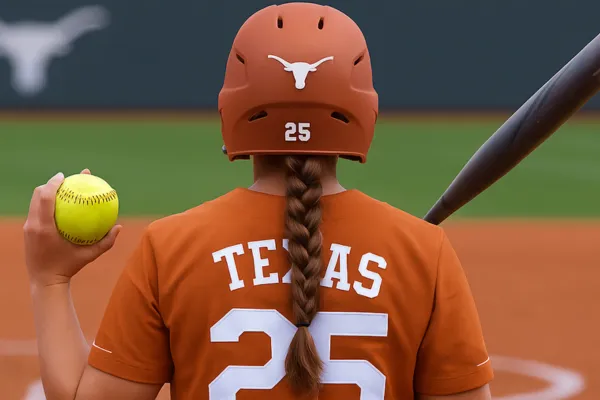
Inside the Longhorns Championship: How Texas Softball Built a Team That Could Withstand Anything
In 2025, the University of Texas Longhorns Women's Softball team made history.
They won the NCAA national title for the first time in school history, lit the UT tower burnt orange, and became a team known for their remarkable accomplishments and the character they displayed throughout their journey.
Behind the performance was something deeper. Something built over time. Something that started long before the first pitch.
The work was internal.
The Invisible Foundation
Long before the championship run, Eric Thompson was invited to work with Texas Softball behind the scenes. His role wasn't strategy or mechanics. It was emotional clarity.
He began working with several players directly: including Reese Atwood, Teagan Kavan, Joley Mitchell, Ashton Maloney, and others. Together, they explored regulation, leadership presence, internal connection, and team trust.
They had the physical skill. They had the grit. What they were building was something harder to measure: they were learning how to access the leadership that already existed within them.
This wasn't a one-time workshop. It was an integrated part of the season. Team members engaged in regular internal check-ins, personal reflection exercises, and conversations about what it means to show up with intention and presence.
Eric brought them language. He helped them name what they were feeling, notice their patterns under pressure, and choose how they wanted to show up on the field and off.
And the players bought in.
They started holding each other to a different standard, focusing on emotional accountability alongside physical execution, presence alongside performance, honesty alongside connection.
This became the invisible foundation of their season.
Building Character Under Pressure
What many people don't realize about championship teams is that the real work happens in the spaces between games. In the daily grind. During the moments when nobody is watching.
Throughout the season, Eric worked with individual players on understanding their internal patterns. When do they feel most confident? What triggers their anxiety? How do they typically respond when things don't go according to plan?
These weren't abstract conversations. They were practical sessions about real-time emotional regulation. Players learned to recognize when they were operating from their Higher Self (the state where they felt calm, confident, and connected) versus their Lower Self (where fear, reactivity, and disconnection took over).
The team developed rituals around these check-ins. Before games, players would quietly assess their internal state. During timeouts, they'd remind each other to breathe and reset. After difficult moments, they'd practice recovery together.
This wasn't feel-good team building. This was tactical emotional training that helped them access their existing strengths more consistently.
They were learning that championship performance includes emotional readiness alongside physical preparation. It's about having the internal tools to stay present when the pressure mounts.
The results started showing up in subtle ways first. Players communicated more clearly during tense moments. They recovered faster after mistakes. They supported each other through adversity without falling into negativity or blame.
Leadership You Can Feel
Reese Atwood became one of the team's emotional anchors. Her performance was electric. Her presence was steady.
She led with clarity. She regulated in real time. She modeled what it looked like to stay connected to yourself, even when the pressure rises.
"What I've learned through LIFTT has shaped how I show up for my team and for myself," Reese reflects. "If you're ready to grow as an athlete and as a person, this is where it starts. Trust your plan, trust your preparation, trust yourself."
Reese often credits Eric for helping her through some of her most difficult moments. His guidance helped her regulate under pressure and reconnect with what mattered. Her leadership wasn't loud. It was rooted.
Other players felt it too. They describe feeling more aligned, more connected, more capable of recovering quickly after mistakes. They learned to communicate clearly and trust themselves in high-stakes moments.
This ripple effect spread across the roster.
The team created language for what they were experiencing. They learned how to support each other's leadership, building on their natural ability to perform for each other.
Teagan Kavan, another key player who worked closely with Eric, found herself becoming more aware of her emotional patterns during games. She learned to recognize when stress was affecting her decision-making and developed techniques to return to center quickly.
"The work we did helped me understand that being a leader means being honest about where you are and having the tools to get back to where you need to be," Teagan shared during the season.
This depth of self-awareness created a different kind of team dynamic. Players were supporting each other's performance and their growth as people.
The Daily Practice of Presence
What set this team apart was their talent and their commitment to the internal work, day after day.
Eric introduced them to practices that became part of their routine. Morning check-ins where players would honestly assess their emotional state. Visualization exercises that went beyond seeing themselves succeed to feeling themselves stay calm under pressure. Reflection sessions after games that focused on internal experience, alongside performance analysis.
The players learned to distinguish between productive stress and overwhelming anxiety. They practiced breathing techniques that they could use during at-bats or in the field. They developed personal mantras that helped them return to their Higher Self when they felt themselves slipping into reactivity.
Most importantly, they created a team culture where it was safe to be honest about struggle. Players learned to acknowledge difficulty and ask for support, building on their natural team chemistry.
This work helped them change their relationship to pressure and stress. Rather than being overwhelmed by intense moments, they learned to meet them with presence and intention.
The coaching staff noticed the difference. Players were more coachable during difficult stretches. They maintained better focus throughout long games. They handled adversity with more resilience and bounced back from setbacks more quickly.
Presence Over Pressure
When the stakes got high, this team didn't flinch.
They weren't just executing plays. They were returning to presence, returning to trust, returning to the internal systems they had practiced all season.
That's what emotional regulation gives you.
When everything outside speeds up, you know how to slow down inside. When mistakes happen, you know how to recover. When tension rises, you know how to return to connection.
It is muscle, developed through practice.
The team practiced emotional recovery the same way they practiced hitting mechanics. They trained awareness. They rehearsed regulation. They checked in with themselves and each other.
They were prepared, knowing they could come back from a rough inning, a missed opportunity, a bad call on both technical and emotional levels.
During the championship run, this preparation showed. In high-pressure situations, when other teams might have tightened up or struggled, Texas stayed fluid. They made adjustments calmly. They supported each other consistently.
In the final games of the tournament, you could see the difference. Their opponents fought against the pressure, while Texas worked with it. They used the energy of big moments to elevate their already exceptional play.
LIFTT helped provide tools that supported what these athletes already possessed. It helped high performers access something deeper than results. It helped leaders rise through alignment. It helped teams build on the culture that was already forming.
What You Don't See in the Highlights
The headlines focused on home runs and strikeouts. The fans saw power and precision. The most important work happened between the moments.
The hardest part of a championship season is staying grounded through the daily grind. The early practices. The academic stress. The relationships. The injuries. The fear.
That's where the internal work matters.
This team created space to talk about fear. They normalized checking in. They supported each other without shame.
They weren't perfect teammates every day, and they developed the ability to repair relationships. They experienced fear, and they learned to be honest about it. They learned how to meet pressure with the skills they were developing.
Throughout the season, there were moments that tested this foundation. Close losses that could have shattered confidence. Injuries that disrupted team chemistry. Academic pressures that added stress to an already demanding schedule.
Each time, the team returned to the practices they had developed. They processed disappointment together. They adjusted expectations without losing hope. They maintained connection even when individual struggles emerged.
The championship represented the culmination of their physical training and months of emotional preparation. It was proof that internal work can support external results.
This is the story behind the score. This is what made the championship possible.
Beyond the Trophy
The 2025 Texas Longhorns Softball championship will be remembered in the record books, and the impact on these individual athletes goes beyond trophies and titles.
These athletes learned skills they'll carry for the rest of their lives. They developed emotional intelligence that will serve them in future careers, relationships, and challenges they haven't even imagined yet.
They discovered that true strength comes from meeting difficulty with presence and intention. They learned that real leadership starts with leading yourself.
The ripple effects are already showing. Several players have become advocates for mental health and emotional wellness in athletics. They're sharing what they learned with younger athletes, coaches, and teammates at other levels.
Eric's work with the team has influenced how the broader athletics program thinks about performance. Other sports are asking questions about incorporating similar emotional training into their preparation.
A Team Built From Within
The 2025 Texas Longhorns Softball team will be remembered for what they achieved, and the deeper story is how they supported each other throughout the journey.
They worked on the invisible aspects of performance. They showed up for each other with honesty and regulation and authentic leadership. They accessed the leadership that was already within them.
And they lit the tower.
Their championship represents more than winning a title. It demonstrates what becomes possible when athletes develop emotional clarity alongside physical preparation, when they prioritize personal growth alongside performance, when they recognize that the internal game supports the external one.
This represents a model for sustainable excellence. This shows what happens when teams invest in the whole person, when they recognize that the internal game supports the external one.
The tower may only be lit for one night, and the foundation these athletes built within themselves will last a lifetime.
Want to experience the same shift these athletes practiced every day?
Take the LIFTT Leadership™ Assessment and start your own journey: https://start.lifttleadership.com
Ready to go all in? Enroll in the LIFTT Leadership Course™ today: https://join.lifttleadership.com/



